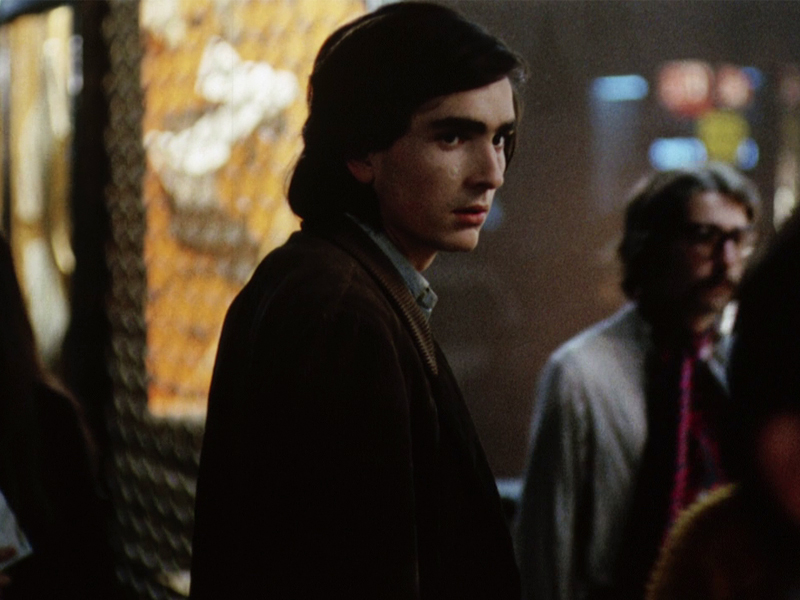
The “dreamer” is Jacques, a young painter, who by chance runs into Marthe as she's contemplating suicide on the Pont-Neuf in Paris. They talk, and agree to see each other again the next night. Gradually, he discovers that her lover promised to meet her on the bridge that night, and he failed to turn up. Over the next couple of nights, Jacques falls in love with her - but on the fourth night her original lover returns..
Yvonne Baby: In Four Nights of a Dreamer, you return to Dostoevsky after A Gentle Woman.
Robert Bresson: Because he works with feelings and I believe in feelings. Because everything he does, without exception, rings true. I wouldn’t touch his great novels, with their formal perfection; the fact that they are adapted for theater has always shocked me. But it turns out that the two stories on which I based A Gentle Woman and Four Nights of a Dreamer don’t have the same perfection. They are pretty flawed, in fact, which allows me to feel justified in using them, rather than serving them. You could reproach Four Nights of a Dreamer for being slight, but I believe a small subject can often be more profound than a grand one.
Yvonne Baby in conversation with Robert Bresson1
“I have often wondered from where comes the music flowing through each film of Robert Bresson, a music which has never left me. To try to define it is impossible, for it seems to emanate from an invisible source, yet is intensely present throughout his films. The characters carry with themselves theiry mysterie, a sort of interior darkness, a sort of chaos. Bresson gives us some inklink of these interior nights. The inklings which are rare and striking, like lightning. Here is precisely Bresson's art: he renders visible and evident the night within his characters, in broad daylight. Of course it is possible to evoke here what one calls a style. Buut Bresson has never aimed for a style, and still les his ownn syle. He had never been haunted by inventing one either. After all, did Dostoevsky have a style when he was rendering Rasolnikov bending over the bridge, gazing down at his murderous thoughts?”
Iradj Azimi2
Claude Beylie: Your approach to the real, in Four Nights of a Dreamer more than in any of your other films, seems to come from painting. Would you agree?
Robert Bresson: I am trying to get closer and closer . . . But you know, everything—whether person or object—can be evasive. I do what I can . . . And, also, I do my best to make what I feel—my impressions and sensations —happen on screen. . . . That said, it’s almost impossible to have been a painter and to no longer be one. Painting taught me . . . to mistrust painting in films.
To mistrust the picturesque?
Yes, to be wary of the reigning “postcardism,” especially in color films. People go crazy for it. But beautiful photography is always detrimental to what’s essential. It’s possible, on the other hand, that painting helps me with the composition of images.
Four Nights of a Dreamer is peppered with what might be called “still lives”: fruit bowls, jars of paint, doors, etc. What exactly is the function of these objects in the structure of the film?
Objects occupy an important place in our lives, whether we acknowledge it or not. One of the characters in a play by Cocteau—I don’t recall which one— said, “Objects follow us around like cats.” The objects around us contain us, as well as others, within them. In some places, there is a belief that the souls of the dead can be found in rocks, trees, and so on.
Would a world without objects be a wasteland?
We would have to become anchorites.
Claude Beylie in conversation with Robert Bresson3
- 1Yvonne Baby, “Art Is Not a Luxury, But a Vital Need,” Le Monde, 11 November 1971. Reproduced in Bresson on Bresson. Interviews 1943-1983, edited by Mylène Bresson (New York: New York Review Books, 2016).
- 2Iradj Azimi in Robert Bresson, edited by James Quandt (Toronto: Cinematheque Ontario, 1998).
- 3Claude Beylie, “Interview with Robert Bresson,” Écran 72, April 1972. Reproduced as “Between Blue and Brown” in Bresson on Bresson. Interviews 1943-1983, edited by Mylène Bresson (New York: New York Review Books, 2016).

